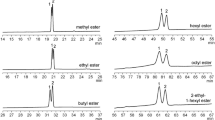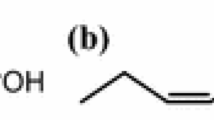Abstract
Different chromatographic methods, thin-layer chromatography (TLC), gas chromatography (GC), gas chromatography/mass spectrometry (GC/MS) and normal- and reversed-phase high-performance liquid chromatography (HPLC), were compared for their ability to separate the different lignans present in fourSesamum species,viz., S. indicum Linn.,S. alatum Thonn., S. radiatum Schum & Thonn. andS. angustifolium (Oliv.) Engl. The advantages and limitations of each method are discussed, and a combination of methods is suggested for qualitative analyses. Two-dimensional TLC was found to be a valuable qualitative technique and one-dimensional TLC is useful for preparative purposes. GC is a good supplement for qualitative analysis, but it had many limitations as a quantitative tool—it involves many preparative steps, no suitable internal standard was found to be commercially available and the various lignans had markedly different response factors. GC/MS is a necessary techniqee to confirm the identity of the lignans present. HPLC is a one-step technique suitable for quantitative analyses, and is fast and simple because it involves direct injection of oil solutions. Reversed-phase HPLC was unable to separate sesamolin and sesangolin, but a normal-phase silica column provided satisfactory separation for these two lignans. 2-Episesalation ofS. alatum, however, did not elute from the normalphase column. Once lignans are identified, a relevant HPLC method can be used for quantitative analyses. Sesamin was present in large amounts inS. radiatum, in considerable amounts inS. indicum andS. angustifolium, and in small amounts inS. alatum. Sesamolin occurred in considerable amounts inS. indicum andS. angustifolium, but only in small amounts in the other two wild species studied.Sesamum alatum was characterized by high amounts of 2-episesalatin, andS. angustifolium was characterized by high levels of sesangolin.
Similar content being viewed by others
References
Tashiro, T., Y. Kukuda, T. Osawa and M. Namiki,J. Am. Oil Chem. Soc. 67:508 (1990).
Budowski, P. and K.S. Markely,Chem. Revs. 48:125 (1951).
Fukuda, Y., and T. Osawa,Agric. Biol. Chem. 49:301 (1985).
Fukuda, Y., M. Nagata, T. Osawa and M. Namiki,J. Am. Oil Chem. Soc. 63:1027 (1986).
Fukuda, Y., M. Nagata, T. Osawa and M. Namiki, —Ibid.50:857 (1986).
Ashri, A., inOil Crops of the World, edited by G. Röbbelen, R.K. Downey and A. Ashri, McGraw-Hill, Inc., New York, 1989, pp. 375–387.
Anonymous, inSesame: Status and Improvements, edited by A. Ashri, FAO Plant Production and Protection, Paper 29, 1981, p. 192.
Anonymous, inSesame and Safflower: Status and Potentials, edited by A. Ashri, FAO Plant Production and Protection, Paper 66.
Kamal-Eldin, A., G. Yousif, L.Å. Appelqvist and G.M. Iskander,J. Fat Sci. and Technol. 94:254 (1992).
Kamal-Eldin, A., L.Å. Appelqvist, G. Yousif and G.M. Iskander,J. Sci. Food and Agric. 59:327 (1992).
Kamal-Eldin, A., G. Yousif and L.Å. Appelqvist,J. Am. Oil Chem. Soc. 68:844 (1991).
Kamal-Eldin, A. and G. Yousif,Phytochemistry 31:2911 (1992).
Jones, W.A., M. Beroza and E.D. Becker,J. Org. Chem. 27:3232 (1962).
Bedigian, D., D.S. Seigler and J.R. Harlan,Biochem. System. and Ecology 13:133 (1985).
Fukuda, Y., T. Osawa, S. Kawagishi and M. Namiki,J. Japanese Soc. Food Sci. and Technol. 35:483 (1988).
IUPAC Standard Methods for the Analysis of Oils, Fats and Derivatives, 7th edn., edited by C. Paquot, and A. Hautfenne, Blackwell Sci. Publications, 1987, pp. 157–162.
Itoh, T., T. Tamura and T. Matsumoto,J. Am. Oil Chem. Soc. 50:300 (1973).
Kamal-Eldin, A. and L.Å. Appelqvist, —Ibid. 71:149 (1994).
Author information
Authors and Affiliations
About this article
Cite this article
Kamal-Eldin, A., Appelqvist, L.Å. & Yousif, G. Lignan analysis in seed oils from fourSesamum species: Comparison of different chromatographic methods. J Am Oil Chem Soc 71, 141–147 (1994). https://doi.org/10.1007/BF02541548
Received:
Accepted:
Issue Date:
DOI: https://doi.org/10.1007/BF02541548




